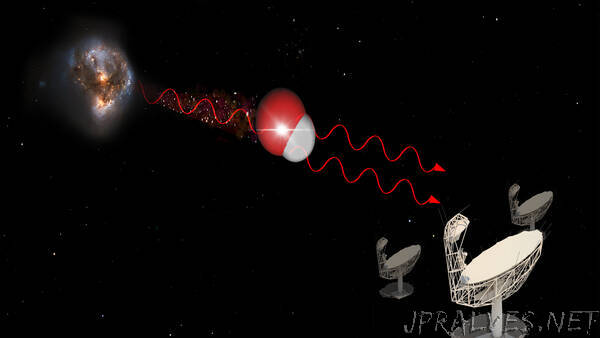
“An international team of researchers, including four Rutgers astronomers, has discovered a powerful megamaser — a naturally occurring, astronomical, radio-wavelength laser — in a galaxy nearly five billion light years from Earth.
The furthest of its kind, the megamaser was detected by South Africa’s “MeerKAT,” a radio telescope consisting of 64 antennas. Megamasers produced by hydroxyl (OH) molecules are considered reliable tracers of gas-rich galaxy mergers, which are locations of intense star formation.
An astronomical maser occurs when some components within a galaxy (like gas clouds) have the right physical conditions and the right alignment to radiate intense energy (in this case, microwaves).
When two galaxies collide, their gas can become extremely dense, leading to the formation of large numbers of hydroxyl (OH) molecules made up of one oxygen atom and one hydrogen atom. These OH molecules can then produce a bright signal called a maser, which is similar to a laser but that emits radio waves rather than visible light. Megamasers are powerful masers produced in galaxy collisions, like beams from cosmic lighthouses.
The observation was made as part of a project known as LADUMA or “Looking at the Distant Universe with the MeerKAT Array.” The LADUMA team named the megamaser “Nkalakatha,” an isiZulu word for “big boss.”
“Nkalakatha is one of the most powerful OH megamasers known, and it’s the most distant megamaser of its kind ever discovered, so it is truly a ‘big boss,’” said Rutgers Professor Andrew Baker, one of three leaders of the LADUMA team. “We expect it is only the first of many OH megamasers that will be discovered as the project continues.”
The main goal of LADUMA is to use radio-wavelength observations of gas in distant galaxies to help understand how galaxies have evolved over the last nine billion years of cosmic time. Because these radio signals are faint, the researchers aim to obtain thousands of hours of observations with MeerKAT to detect them. The data are analyzed using a cloud-computing facility supported by the Inter-University Institute for Data-Intensive Astronomy (IDIA).
“MeerKAT produces beautiful data, and it will be both challenging and rewarding to dig deeper into these data in pursuit of ever fainter and more distant galaxies,” said study co-author and Rutgers graduate student Amir Kazemi-Moridani.
A complete understanding of how galaxies evolve over cosmic time also requires observations at other wavelengths like visible light and X-rays. Rutgers astronomers and study co-authors Professor Eric Gawiser and Professor Jack Hughes are world experts in those areas.
The researchers said radio astronomy is entering an exciting time, with plans in the United States to build a “next-generation” Very Large Array (ngVLA). The unprecedented amounts of data this and other telescopes will collect will enable new discoveries as exciting and unexpected as Nkalakatha.
Other LADUMA scientists are from Australia, Chile, France, Germany, India, Italy, Japan, the Netherlands, South Africa, South Korea, Spain, and the United Kingdom in addition to the United States.
The Rutgers team’s contribution to this work was supported by the U.S. National Science Foundation.”
